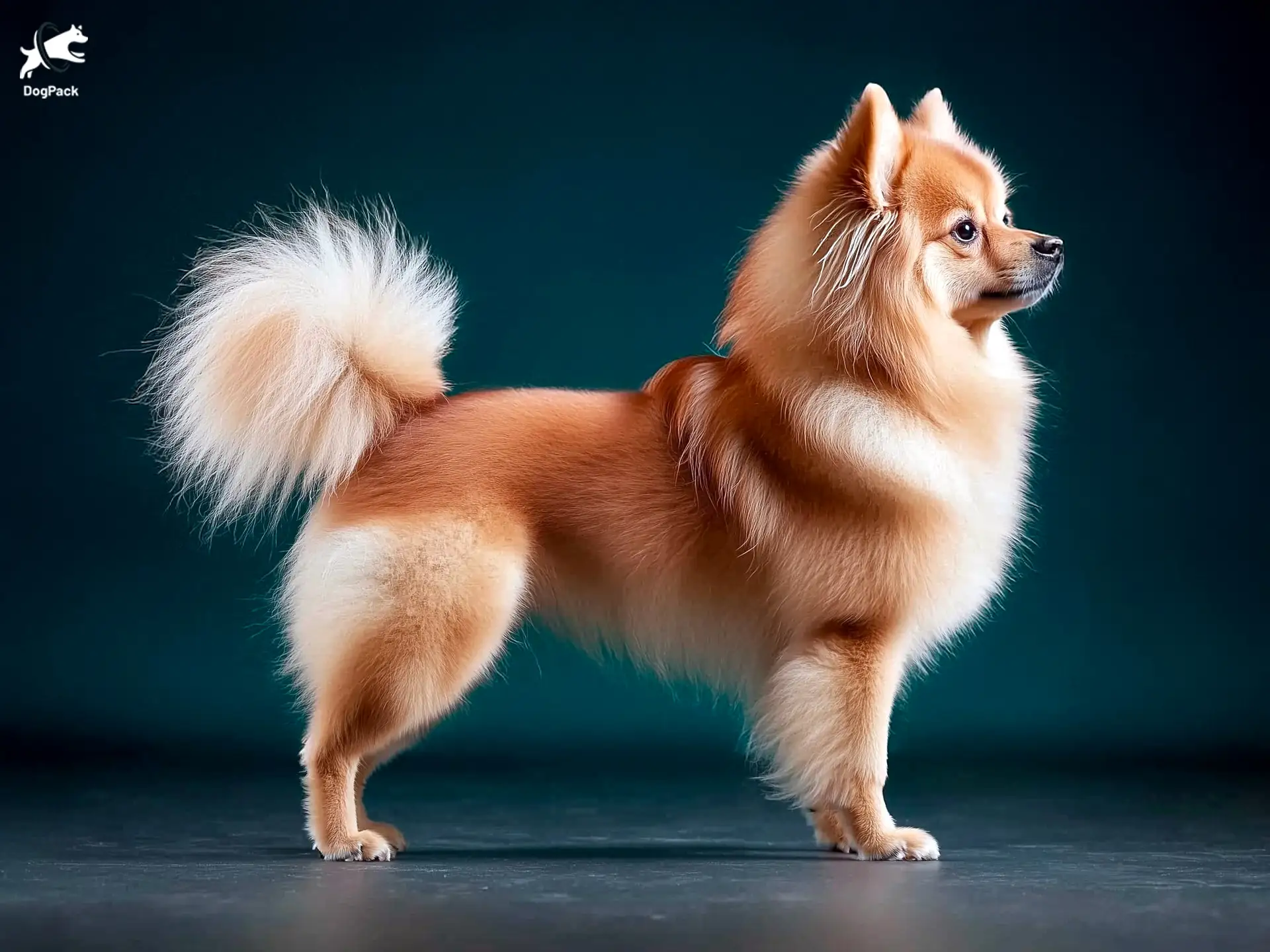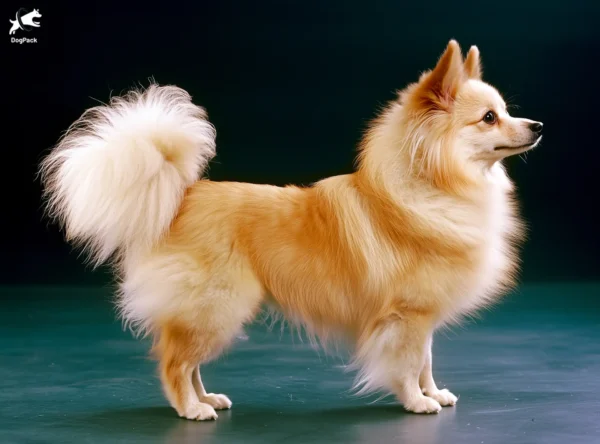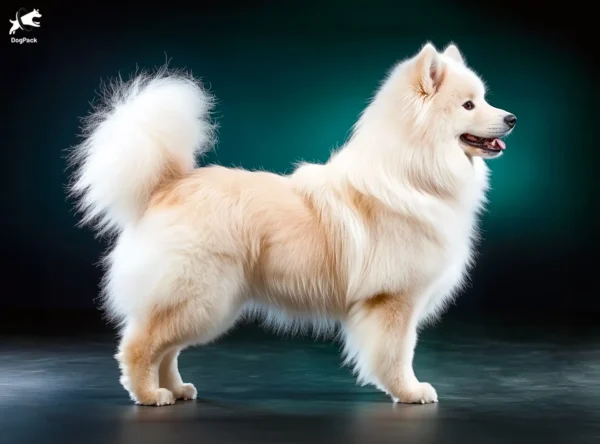Throwback Pomeranian Dog Breed Info & Overview
Despite their bigger stature, these pups share the same lineage as the classic Pomeranian. Known for their sturdier build and captivating expressions, they trace their heritage back to spitz-type working dogs. With a spirited demeanor and notably fluffier appearance, they offer a nostalgic glimpse into the Pomeranian’s roots while still bringing plenty of modern-day charm.
Key Differences
| Feature | Standard Pomeranian | Throwback Pomeranian |
|---|---|---|
| Size | 3–7 lbs (1.4–3.2 kg) | 10–20 lbs (4.5–9 kg) |
| Coat | Fluffy, dense | Less fluffy but still thick |
| Appearance | Small, toy-like, short snout | More Spitz-like, longer snout |
| Temperament | Playful, energetic, companion dog | Energetic, may have stronger working instincts |
| Health | More prone to toy-breed health issues | Generally healthier |
Characteristics
Pictures
Breed History
Originally hailing from the Pomerania region in Northern Europe, these larger variants reflect the breed’s working-dog ancestry before intense miniaturization. Early German Spitz dogs were sturdier, often weighing well over 10 pounds. Over time, selective breeding produced the tiny companion we see in toy groups today. However, some litters still display bigger pups that hint at this rich heritage, now affectionately called “throwbacks.”
Centuries ago, these spitz dogs were valuable on farms and in households for their vigilance and devoted companionship. Renowned for their dense coats and keen awareness, they guarded property and helped with smaller tasks. As fashions changed in royal courts, smaller Pomeranians grew more popular, a trend famously championed by Queen Victoria. Yet a few pups stubbornly retained their robust ancestral size.
The term “Throwback Pomeranian” reflects a genetic reversion to those ancestral traits. They embody a closer resemblance to the original spitz prototype—bigger frames, slightly longer muzzles, and a more robust presence. Despite this size difference, they remain purebred dogs under the Pomeranian umbrella. Enthusiasts today appreciate them for preserving a piece of living history, blending old-world sturdiness with modern pom charm.
Temperament, Personality
These energetic canines are bright, confident, and fiercely loyal. Expect them to zip around the house, investigating every nook and cranny with genuine curiosity. Their alert nature often makes them quick to bark at unfamiliar noises or guests. Early and consistent socialization helps them distinguish friend from foe, ensuring a well-balanced dog that remains attentive without becoming overly vocal.
Although spirited, they thrive on human companionship and do best in environments where they can interact frequently with family. They tend to form tight bonds, sometimes choosing one favorite person. However, with the right introduction, they get along well with older children and other pets. Their larger-than-typical size can be a bonus— they’re less delicate than tiny Pomeranians and more tolerant of gentle play.
A Throwback Pomeranian can display occasional bouts of stubbornness, especially if they sense uncertain leadership. Patience and consistency go a long way when shaping their behavior. They relish mental stimulation, so puzzle toys or short obedience drills work wonders to keep them engaged. All in all, they remain cheerful companions that thrive in a home that offers them both structured activity and loving attention.
Physical Characteristics
One glance at this big Pom variation, and it’s clear they differ from their smaller cousins. Their frames can be nearly twice as large, typically reaching up to 20 pounds. Even so, they keep the trademark plush coat, though it may be slightly less dense than the standard show-type Pom. The tail arches proudly over the back, highlighting their spirited spitz lineage.
Their heads often feature a slightly elongated muzzle, giving them a classic fox-like profile. Ears are small, erect, and triangular, exuding a constant alertness. Eye shape remains almond-like, contributing to their bright, watchful gaze. Though color variations can span a wide range—orange, cream, black, sable—these bigger pups consistently exude an old-world charm, especially noticeable in their more pronounced stature and confident stance.
Typically, the coat consists of two layers: a fluffy undercoat and a straighter outer layer. Despite being labeled “less dense,” the fur is still abundant. Regular brushing highlights their full mane around the neck and shoulders, a signature feature shared with smaller standard Poms. Combined with a sturdy torso and muscular legs, the Throwback Pomeranian silhouette stands apart from its toy-sized brethren while maintaining a familiar spitz elegance.
Health Issues
Overall, these bigger variations tend to be healthy. They may face fewer issues with tracheal collapse or luxating patellas compared to smaller Pomeranians. However, they’re not immune to common breed concerns such as dental disease. Regular veterinary checkups and diligent oral care are essential to avoid periodontal complications. VCA Hospitals offers a comprehensive overview of canine dental issues worth reviewing.
Another area to watch is their joints. Though sturdier, they can develop hip or elbow dysplasia if overfed or improperly exercised during puppyhood. Moderating high-impact activities and ensuring healthy weight management helps reduce stress on growing bones. As with any purebred, it’s crucial to consult breeders who perform health screenings and provide a documented medical history for both parents.
Eye health also deserves attention. Progressive Retinal Atrophy (PRA) can occur in Pomeranians, so early screenings and routine eye examinations can catch issues early. Some lines can carry other inherited conditions, but conscientious breeders aim to minimize risks through genetic testing. Keeping an eye on daily energy levels and coat quality can also act as an early indicator of underlying health challenges.
Grooming Needs
Many potential owners worry about intense grooming, but the Throwback Pomeranian’s coat, though still thick, can be more manageable than that of a show-type Pom. A thorough brushing two to three times a week generally prevents tangles and helps distribute natural oils. Using a slicker brush or a pin brush on the outer layer keeps the fur looking neat.
During heavy seasonal shedding, daily brushing might be necessary to keep loose hair under control. Because of their abundant undercoat, a comb that reaches the skin is beneficial to remove dead fur and avoid matting. Occasional baths—every six to eight weeks—usually suffice unless they get into something messy. Using a dog-specific gentle shampoo and conditioner helps maintain coat and skin health.
Routine ear checks, nail trims, and dental care are equally crucial. Trimming nails at least once a month prevents discomfort or posture issues. Cleaning ears every couple of weeks with a vet-approved solution can deter infections. Finally, pay special attention to dental hygiene. Regular teeth brushing reduces plaque buildup—a common concern in small dog breeds like Pomeranians.
Exercise Requirements
Don’t let their size fool you. These fluffballs have energy to burn. They appreciate regular walks, structured play, and even short bursts of agility activities. A daily routine of 45–60 minutes of moderate exercise helps maintain their ideal weight and keeps their minds active. Quick fetch sessions in the yard or indoor puzzle toys are perfect ways to channel that enthusiastic spirit.
While robust, they shouldn’t be pushed too hard—especially as puppies—to protect growing joints. Gradually increase activity intensity to match their development stage. Once fully matured, some enjoy hikes or longer strolls, provided you build endurance gradually. Keep an eye on signs of overheating, particularly in warmer climates, since their double coat can trap heat during intense activity.
These canines also relish mental challenges. Teaching them to retrieve hidden toys or practicing trick training fosters mental stimulation. Interactive puzzle feeders transform mealtime into a brain game, preventing boredom. Even short, purposeful sessions throughout the day can keep them happy. Unlike truly high-energy working breeds, they appreciate rest breaks and can adapt to apartment living, as long as they get consistent daily exercise.
Training Tips
A Throwback Pomeranian responds well to positive reinforcement—treats, praise, and occasional toy rewards. Gentle correction methods tend to be most effective, as harsh discipline can create fear or stubborn resistance. Begin basic commands early: “sit,” “stay,” and “come” lay a foundation of good behavior. Short, focused sessions prevent boredom, and rotating training drills keeps things interesting for these inquisitive fluffballs.
Socialization is key. Introducing them to various sounds, environments, and friendly strangers during puppyhood curbs excessive guarding or timidness. Consistent routines also help with housetraining, especially since smaller dogs can be prone to accidents if not closely supervised. Crate training offers a safe den-like space and can expedite potty training while providing them with a comfortable retreat.
Though bright, they can be self-assured. If they sense any indecision from the owner, they might try to lead the show. Establishing a calm, confident approach signals your role as pack leader. Ensure you keep sessions fun and upbeat; pepper in quick play breaks to maintain enthusiasm. By blending clear boundaries with positive interaction, these spirited canines develop into well-mannered companions.
Nutrition, Diet
Because this variant can weigh up to 20 pounds, their caloric needs differ from standard miniature Pomeranians. Most healthy adults do well on roughly 300–450 calories daily. Look for a diet formulated for small-to-medium dogs that incorporates high-quality protein sources. Fish meal or chicken meal can be excellent protein bases. Ensure moderate fat levels to help maintain that thick coat without causing excess weight gain.
Split meals into two servings—morning and evening—to support steady energy levels throughout the day. Some owners opt for portion-controlled kibble combined with wet or home-cooked elements for palatability. Always avoid foods with excessive fillers like corn or soy. If your Throwback Pomeranian is highly active, consult with a vet to adjust their intake or add supplements for joint and coat health.
Watch for overfeeding, especially since these dogs are quick to charm extra snacks from unsuspecting family members. A waistline check—where you can feel but not see the ribs—helps ensure the pup is at a healthy weight. Offer nutrient-dense treats (like small bits of cooked lean meat) during training sessions, but keep track of overall caloric intake to prevent creeping weight gain over time.
Adoption, Breeders
Locating a reputable source for a larger Pom can be challenging. Start by searching for breeders who specialize in Pomeranian lines known to produce sturdier pups. Insist on health-clearance records to confirm parents are screened for breed-specific conditions. Ask breeders about historical litter sizes and the average adult weights of their dogs to better predict if a puppy might grow into a throwback size.
For those considering adoption, keep an eye on local rescues or organizations dedicated to Pomeranian rehoming. Dedicated owner communities can also be a great resource—consider joining the Throwback Pomeranian Facebook Group to connect with experienced owners and potential rehoming opportunities. Patience is key; it might take time to find an exact throwback match. Always discuss any known health or behavioral background before bringing a new dog home.
If you plan to buy from a breeder, visit in person whenever possible. Ensure puppies are raised in clean, nurturing conditions with ample human interaction. Clarify any guarantees or return policies, plus vaccination and deworming schedules. Connecting with experienced Pomeranian owners and breed-specific communities helps ensure responsible sourcing, which supports the future of this delightful variation.
Family Pet?
Bigger than standard Poms yet still classified under small dog breeds, they often fit well into active families’ routines. Their bold personalities entertain children who can handle them gently. In fact, the sturdier frame is an advantage around curious kids—these dogs aren’t quite as fragile as toy-sized counterparts. Still, it’s best to supervise interactions with very young children to ensure everyone’s safety.
As social butterflies, they generally prefer to be in the mix of family life, whether watching TV with the group or investigating new faces at the door. They bond closely with their humans and can show separation anxiety if left alone for prolonged periods. Teaching them independence early and offering engaging toys or puzzles can help keep them content if you’re away.
When integrated properly, they can coexist with other pets, but slow introductions are vital. Their natural curiosity might lead them to bark at larger dogs initially. With time, many form playful relationships. The key is to ensure neither dog feels overwhelmed. For households already brimming with furry companions, the Throwback Pomeranian can adapt, provided they get consistent one-on-one attention.
Right For You?
Before welcoming one into your home, evaluate your lifestyle. These dogs crave human interaction and moderate daily activity. If you’re frequently away or prefer a low-energy lapdog, this might not be the perfect fit. However, if you relish a spirited companion that appreciates both fun and downtime, their bigger size could be a bonus—less fragility and a heart still brimming with Pomeranian spunk.
Space-wise, they adapt well to apartments, as long as you commit to proper exercise. If you enjoy short walks, easy hikes, or interactive indoor play, they’ll eagerly join in. Grooming requires moderate upkeep but isn’t overwhelming for dedicated owners. Ultimately, if you seek a unique take on a classic breed—one that captures the best of spitz qualities—this pup could be just right for you.
Conclusion
A Throwback Pomeranian merges the treasured traits of a standard Pom with a resilient, larger build rooted in its working-dog ancestry. For those drawn to the Pomeranian’s spunky charm but prefer a sturdier companion, this old-style variation may be the ideal fit. With proper training, moderate exercise, and attentive grooming, these dogs blossom into delightful family members that carry a special link to the breed’s past.
FAQs
-
How is a Throwback Pomeranian different from a standard Pomeranian?
A Throwback Pomeranian is larger and closer to the original Spitz-type ancestors. Unlike the teacup-sized standard Pomeranians, throwbacks typically weigh 10-20 pounds, have longer legs, a sturdier frame, and a more moderate coat.
-
Can a Throwback Pomeranian still compete in dog shows?
No, Throwback Pomeranians do not meet the breed standard set by major kennel clubs like the AKC, which require Poms to weigh under 7 pounds. However, they excel in agility, obedience, and companion roles due to their athletic build.
-
Are Throwback Pomeranians healthier than standard Pomeranians?
Yes, Throwback Pomeranians generally have fewer health issues than their smaller counterparts. Their larger size reduces risks of tracheal collapse, dental overcrowding, and luxating patellas, making them a hardier and more robust companion dog.
-
Do Throwback Pomeranians have the same temperament as standard Pomeranians?
Yes, but they tend to be more active and independent due to their closer genetic link to working Spitz breeds. They are still affectionate, intelligent, and loyal but may require more exercise and mental stimulation to stay happy.
-
Where can I find a true Throwback Pomeranian?
Since Throwback Pomeranians are not selectively bred, they occasionally appear in litters of standard Pomeranians when genetics revert to their Spitz ancestry. Ethical breeders or rescue organizations may have larger-than-average Pomeranians available.
Breed Ratings
The Throwback Pomeranian is clever and picks up commands quickly when motivated by treats and praise.
Brimming with energy, they excel at interactive play and enjoy toys and games throughout the day.
A spirited pup that appreciates daily walks, short hikes, and plenty of mental stimulation.
Their double coat can shed heavily during seasonal transitions, requiring consistent grooming.
Although they may chase small critters, they’re not as driven as some other spitz breeds.
Weekly brushing is a must, and extra care during shedding seasons helps keep their coat tangle-free.
Eager and bright, they respond well to positive methods but need consistency to curb stubborn streaks.
They form strong bonds and may experience anxiety if left alone for extended periods.
Alert by nature, they can be vocal if not properly socialized and trained.
Generally a low-drool breed, even with a slightly longer muzzle than toy Poms.
Tends to coexist well with other canines, but slow, careful introductions are recommended.
Typically robust, they can still face some common Pomeranian health issues if not carefully managed.













